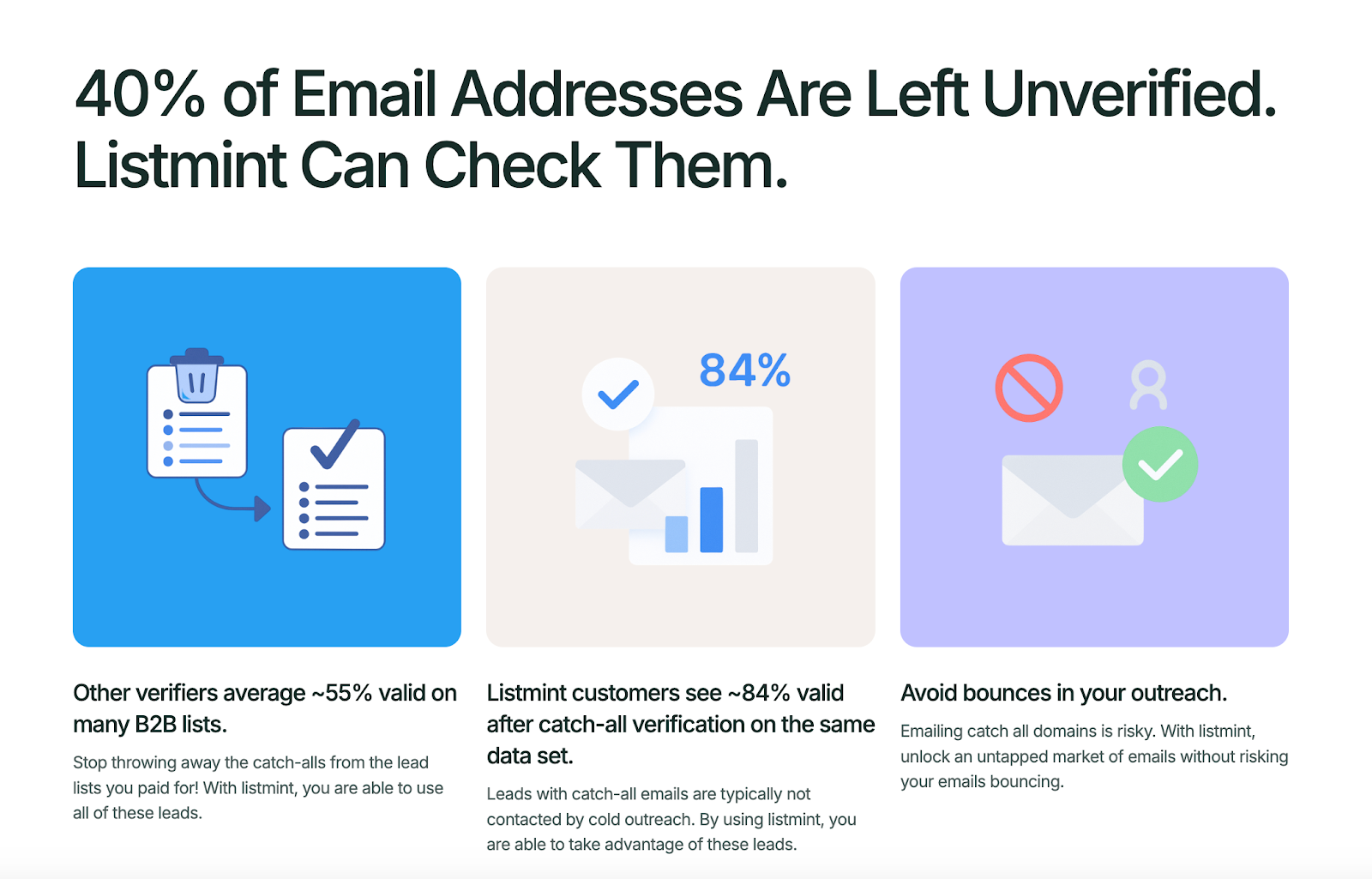
Strong email performance depends on the quality of the contact list behind it.
When inboxes are filled with fake details, abandoned accounts, or outdated records, every message sent carries more risk than reward. Bounce rates rise, domain reputation weakens, and campaigns reach fewer real people.
Clean data is the foundation of a healthy email program. A well-maintained list helps messages reach recipients’ inboxes, keeps engagement strong, and prevents wasted effort on contacts that will never respond.
In this guide, we’ll walk through proven practices that protect list health, reduce deliverability issues, and keep campaigns connected to the right audience.
Email list cleaning (or email scrubbing) is the process of keeping contact lists accurate and safe to use. It means finding and removing invalid email addresses, fake email addresses, duplicate contacts, and outdated email addresses that hurt campaign results.
A clean email list improves inbox placement and helps messages reach real people instead of bouncing back.
List cleaning is different from email validation and verification. Cleaning focuses on removing bounced email addresses, inactive subscribers, and unengaged contacts.
Validation checks the format of email addresses and flags issues, such as role accounts or duplicate email addresses. Verification confirms valid email addresses that can receive messages, which lowers the risk of emails bouncing or landing in the spam folder.
Most teams use an email list cleaning service or email verification tools to maintain email hygiene. These tools protect sender reputation and help email marketing campaigns perform better with engaged subscribers.
Ignoring list hygiene can cause significant damage to email campaigns. Messages sent to bad data often lead to:
These risks affect more than deliverability. They drain budgets, reduce conversion rates, and make it harder to build trust with engaged subscribers. Campaign reports also become unreliable, leaving teams with poor engagement metrics that do not reflect real performance.
Regular cleaning changes the outcome. It keeps email addresses valid, helps email marketing campaigns focus on active contacts, and protects list health over time.
With stronger data, marketing teams can build an email marketing strategy that drives results instead of wasting effort on unengaged subscribers or bounced emails.
Strong email deliverability depends on more than a one-time clean. Lists decay quickly, and ignoring signs of trouble leads to bounced emails and fewer engaged subscribers. The following moments call for immediate attention:
Knowing when to act is only part of the process. The next step is applying clear methods that keep every email list healthy. These best practices help maintain valid email addresses, protect sender reputation, and improve email deliverability across campaigns:
A clean list begins with the first contact. Signup forms and web forms often collect fake email addresses, duplicate contacts, or invalid email addresses. Without checks, these details damage future email campaigns.
An email verification service can solve this at the entry point. Real-time verification confirms valid email addresses before they reach major email marketing platforms. This protects inbox placement and reduces bounced emails.
Verifying new subscribers at entry helps grow an engaged list. It supports better engagement metrics, improves welcome emails, and builds stronger long-term email marketing campaigns.
Invalid email addresses, duplicate contacts, and outdated email addresses weaken every list. Hard bounces and inactive subscribers waste money and reduce the reach of email marketing campaigns.
Running frequent list cleaning with an email list cleaning service helps remove bounced email addresses and disengaged subscribers before they hurt list health.
Even if removing inactive subscribers lowers subscriber count, it builds an engaged list that improves engagement metrics and email deliverability. Focusing only on valid email addresses keeps list hygiene strong and supports better ROI across every email program.
Catch-all emails accept all messages, even when the address is not real. Many look valid but lead to bounced emails and weaker inbox placement.
Using catch-all verification helps separate valid email addresses from bad ones. An email verification API can confirm which contacts are safe without sending a test email.
When valid addresses are kept through catch-all email validation, the list grows stronger, engagement metrics improve, and email marketing campaigns reach more real subscribers.
Listmint offers real-time catch-all verification with 99%+ accuracy. Get started for free!
A large list is not always a healthy one. Disengaged subscribers bring weak engagement metrics and lower inbox placement, even when valid email addresses are used.
Tracking open rates, click-through rates, and responses helps spot unengaged contacts early. Running a re-engagement campaign gives those subscribers a chance to stay connected before they are removed.
Segmentation keeps the most engaged subscribers in focus. Sending targeted messages to active groups improves conversion rates, strengthens list health, and protects the overall email marketing strategy.
Purchased or scraped lists often include unwanted emails, fake email addresses, and spam traps. Sending to these contacts leads to high bounce rates, more spam complaints, and the risk of blocklisting.
Building lists through opt-in methods keeps email subscribers engaged and better aligns with laws like the CAN-SPAM Act and common ESP policies.
New subscribers added this way are more likely to open, click, and respond to messages, which strengthens engagement metrics and email deliverability.
Focusing on organic growth protects sender reputation and creates an engaged list that supports long-term email marketing campaigns.
Not every unengaged subscriber is a lost cause. Some contacts stop opening emails for a period but may respond with the right message.
A re-engagement campaign gives inactive subscribers a chance to stay connected. Short surveys, updated preferences, or special offers help confirm if they still want to receive emails.
Those who respond remain part of an engaged list, while unengaged subscribers can be safely removed.
Running this step protects subscriber count, improves engagement metrics, and makes sure the entire list is filled with valid email addresses that support stronger email marketing campaigns.
Frequent list cleaning is easier when built into everyday processes. Manual checks often miss duplicate email addresses, invalid email addresses, or inactive subscribers, which leaves gaps in list hygiene.
Using marketing automation with an email list cleaning service keeps data accurate without extra effort.
An email verification tool can connect directly to major email marketing platforms, making sure new subscribers are verified and outdated email addresses are removed in real time.
Automated list cleaning protects engagement metrics, improves email deliverability, and saves time that can be spent refining the email marketing strategy. The result is a clean email list that continues to support long-term ROI.
Cleaning lists manually or with basic verification tools often leaves gaps. Most platforms only verify standard email addresses and label catch-all domains as “risky” or “unknown.” That means a large portion of your list is left out, leading to wasted leads and unreliable results.

Listmint changes this process. With real-time verification that covers both SMTP and catch-all domains, Listmint confirms which addresses are valid and which are not.
Instead of waiting 48 hours or relying on test emails, teams get instant results that protect sender reputation and improve email deliverability across campaigns.

This matters for list cleaning because catch-all email addresses often make up 30–40% of every database. Where other services stop, Listmint verifies them fully, helping businesses recover over 50% more valid emails and build a stronger, more engaged list.
With 1B+ emails already verified, Listmint gives marketing teams reliable data for list cleaning that supports long-term ROI.
For businesses and agencies that want fewer spam complaints, improved email deliverability, and stronger engagement, Listmint is the most effective way to protect list health.
Get started for free today and see how Listmint can help you recover 50%+ more valid emails!

Clean lists are the foundation of successful email programs. Without them, even the best campaigns struggle to reach the right audience.
Regular maintenance protects deliverability, improves engagement, and makes sure every message goes to real people who are ready to connect.
Listmint makes this process easier. With real-time verification, catch-all validation, and accurate reporting, you gain confidence that every email on your list is reliable.
Instead of wasting effort on risky addresses, your campaigns can focus on building stronger relationships and driving better results.
Get started for free today and see how Listmint helps you recover more valid emails and keep your lists ready for every campaign.
Start with an email list cleaning service that removes invalid contacts and verifies valid email addresses. Use double opt-in on every signup form to prevent fake details
A few tools also include blocklist monitoring, which protects sender reputation and keeps campaigns safe.
Clean your list regularly to prevent issues like bounced emails and spam complaints. Removing subscribers who remain inactive after a re-engagement campaign improves list health and email ROI.
Many free tools can help spot duplicate contacts, but professional platforms provide deeper reporting and accuracy.
Email list hygiene is the practice of keeping a contact database accurate, up to date, and free of unwanted emails. It includes removing invalid addresses, monitoring engagement, and making sure only active subscribers receive messages.
Strong list hygiene improves inbox placement, so more emails reach recipients’ inboxes.
Efficiency comes from automation. Connect an email verification API to major email marketing platforms, verify new subscribers instantly, and schedule frequent list cleaning.
If a recipient domain has a downed server, clean, verified data helps separate temporary soft bounces worth retrying from truly invalid addresses, and it avoids wasted sends to contacts who never engage or open a final email.
Automation makes it easier to send emails to real, engaged subscribers only.
Verify all your emails, even Catch-alls in real-time with our Email Verification Software.
Create an account for free.